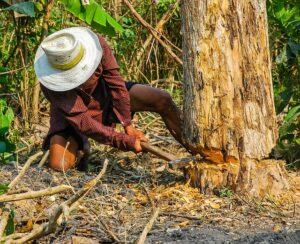Introduction:
Trees act as the lungs of our planet, play an indispensable role in maintaining the ecological balance and supporting life on Earth. Their importance cannot be overstated, and as we face escalating environmental challenges, the protection of trees becomes increasingly urgent.
Thank you for reading this post, don't forget to subscribe!
Benefits of Trees:
1.Oxygen production and Air Quality:
Trees are nature’s air purifiers. With the help of a process called photosynthesis, they absorb carbon dioxide and release oxygen, making the air we breathe cleaner and more oxygen-rich. They act as a natural buffer against air pollution and help mitigate the effects of climate change by sequestering carbon.
2. Habitat and Biodiversity:
Trees provide essential habitats for countless species of birds, insects, and mammals. The intricate ecosystems within forests depend on the diverse flora and fauna that call trees home. Protecting trees means safeguarding biodiversity and preserving critical habitats.
3. Soil Health:
The roots of trees anchor soil, preventing erosion and promoting soil stability. They also help with nutrient cycling, enhancing soil fertility. Healthy soils are vital for agriculture and food production.which is good for health.
4. Climate Change:
Trees are climate warriors. They are invaluable in mitigating climate change by absorbing and storing carbon dioxide, one of the primary greenhouse gases responsible for global warming. Conserving existing forests and reforestation efforts are vital in the fight against climate change, like hot weather.
5. Water Resources:
Trees play a crucial role in maintaining water quality and regulating water cycles. Their canopies reduce the impact of heavy rainfall, preventing flooding and soil erosion. Additionally, they act as natural filters, purifying water as it percolates through their roots. Roots of plants play an essential role in the water cycle.
6. Economic Benefits:
Trees offer economic value through products such as timber, fruits, nuts, and medicinal plants. Sustainable forestry practices ensure that these resources continue to be available for future generations.
Drawback of Cutting Trees:

Cutting trees can have several significant drawbacks, including:
1.Environmental Impact:
Deforestation can lead to the loss of biodiversity, disrupt ecosystems, and contribute to climate change through reduced carbon sequestration and increased greenhouse gas emissions. Greenhouse gases cause global warming.
2.Soil Erosion:
Trees help anchor soil and prevent erosion. Their removal can lead to soil degradation and reduced agricultural productivity. Badly affects our agriculture.
3.Loss of Habitat:
Cutting trees destroys the natural habitats of many wildlife species, like birds leading to population decline or endangerment.
4.Reduced Air Quality:
Trees play a vital role in filtering and purifying the air. Their removal can result in decreased air quality in the environment.
5.Disruption of Water Cycle:
Trees absorb and release water, regulating local water cycles. Deforestation can lead to altered water flow patterns and potentially increased risk of floods and droughts that vastly damage our earth.
6.Aesthetic and Recreational Loos:
Trees provide aesthetic value and recreational opportunities for people. Cutting them can diminish the beauty of landscapes and reduce places for outdoor activities.
7.Economic Impact:
Trees cutting can provide valuable resources like timber, the long-term economic impact of deforestation can be negative due to the loss of ecosystem services and tourism opportunities.
8.Climate Change:
Deforestation contributes to climate change by releasing stored carbon into the atmosphere and reducing the planet’s capacity to absorb carbon dioxide which causes ozone depletion.
9.Risk of Extinction:
Some tree species are endangered, and cutting trees can push them closer to extinction.
It’s important to balance the need for resources with the conservation of forests and the environment to mitigate these drawbacks.
Effects of Deforestation on different species:
Deforestation has an indirect impact on our health, livelihoods, and food.
Effect on Human health:
Forest destruction forces animals to migrate. This considerably increases the chances of contact between humans and animals which in turn can lead to the spread of zoonotic diseases.
Example of Zoonotic Disease:
Mosquitoes transmit malaria to people and mosquito populations thrive as biodiversity declines. According to 2020 research, deforestation increases the chances of malaria spreading.
Effect on Food:
People obtain food and medicine directly from forest plant species or grow crops in fertile soil. Deforestation, the main reason for which is to free up land for conventional agriculture, deprives these people of the resources they need to cultivate food to survive which leads to food insecurity.
To feed the rising populations of cities, conventional agricultural producers transform forests into land that can be used for livestock grazing or palm oil and soy production. As a result, the landscapes lose biodiversity and fertility which ultimately makes them unsuitable for long-term food production.
climatic Effects:
Forest loss contributes to climate change as well as biodiversity loss which plays an important role in the environment. This in turn impacts humans’ health and wellbeing.
Birds Nests :
Forests are home to numerous creatures and cutting of trees destroys their nests.
Effects on Environment:
Soil stability:
Tree roots help to stabilise and hold soil in place but the removal of trees loosens the earth and exposes it to destructive rains and wind. Deforestation thus increases soil erosion.
Global warming:
Trees help to keep the world’s carbon dioxide levels in check as the gas circulates through the air, oceans, and earth. Deforestation releases the stored gas back into the atmosphere thus contributing to global warming . Increasing levels of carbon dioxide cause global warming which destroys the atmosphere.
If deforestation was brought to an end today, this could lead to an annual reduction in greenhouse gas emissions by 10%. Climate experts say that in order to ameliorate the climate change issue, people need to reduce the level of greenhouse gas emissions by half over the next 20 years or reduce the detrimental effects of forestry industry activities.
Flooding:
Trees help with flood control. During intense rainfall, their roots hold the soil in place and at the same time absorb some of the rainwater.But deforestation causes floods.
Effect on Wildlife:
Various industries have been cutting down forest areas for farming, grazing, mining and urbanisation. This means that billions of creatures have lost their habitat.
How to control deforestation?
1.Reforestation:
Planting new trees and restoring damaged forests is a critical step in revitalising our natural environment.
2. Sustainable logging:
If trees must be harvested for economic purposes, it should be done sustainably, ensuring the long-term health of forests.
3. Urban Greening:
Increasing the number of urban trees helps improve air quality and provides shade, reducing the urban heat island effect.
4.Policies:
Governments should enact and enforce laws and policies that protect forests and regulate logging practices. Grow more and more trees.
5. Education and Awareness:
Educating people about the importance of trees and their role in the environment is key to garnering support for tree protection and growth of trees .
6. Community Engagement:
Involving local communities in tree protection and reforestation efforts can build a sense of ownership and responsibility.
Importance of Trees:
Purify air:
Trees purify our air and combat climate change.
Provide Shelter:
Trees provide housing to millions of species that protect us from disease.
Clean streets:
Trees cool our streets and cities.
Protect from Disaster:
Trees protect against floods and water pollution.
Relax Mind:
Trees ease the mind during stressful times.
Conclusion:
Trees are not just silent witnesses to the passing of time; they are active participants in sustaining life on Earth. The protection of trees is not merely an environmental concern but a moral responsibility. As stewards of the planet, we must take concrete actions to ensure that trees continue to thrive, providing the myriad benefits that make life on Earth possible.
FAQ:
Here are some common questions and answers related to tree protection:
Q1.Why is it important to protect trees?
Ans. Trees provide numerous benefits, such as clean air, wildlife habitat, and shade. Protecting them helps maintain a healthy environment and a better quality of life.
Q2.How can I protect trees on my property?
Ans.To protect trees, avoid damaging their roots, keep heavy machinery away, and prune them carefully. Implement a tree care plan and consult an arborist for guidance.
Q3.What are some common tree threats and how can they be prevented?
Ans.Common threats include pests, diseases, and construction damage. Prevention involves regular tree inspections, prompt treatment, and protective measures during construction.
Q4. Is it necessary to obtain permits for tree removal or pruning?
Ans.It varies by location and tree species. Check with your local government or an arborist to determine if permits are required before taking any action.
Q5.How can I protect trees during construction projects?
Ans.Implement tree protection zones, use mulch and barriers, and hire a certified arborist to oversee construction to ensure minimal damage to trees.
Q6.What are the benefits of mulching around trees?
Ans. Mulch helps retain moisture, regulate soil temperature, and prevent competition from weeds, promoting overall tree health.
Q7. How do I choose the right tree for my property to ensure its long-term health?
Ans.Consider factors like soil type, climate, available space, and your maintenance commitment. Consulting with a local nursery or arborist is a good idea.
Q8.What should I do if I suspect a tree on my property is diseased or infested with pests?
Ans.Contact a certified arborist for a professional diagnosis and treatment options. Early intervention is key to saving the tree.
Q9.How can I support urban tree protection efforts in my community?
Ans.Get involved with local tree planting and preservation initiatives, advocate for tree-friendly policies, and educate others about the importance of trees.
Q10.What legal protections exist for trees in urban areas?
Ans. Legal protections vary, but some cities have ordinances and regulations that safeguard significant trees. Check with your local government to learn more about tree protection laws.
These questions and answers should provide a good starting point for your article on tree protection. Feel free to expand on any of them as needed.
